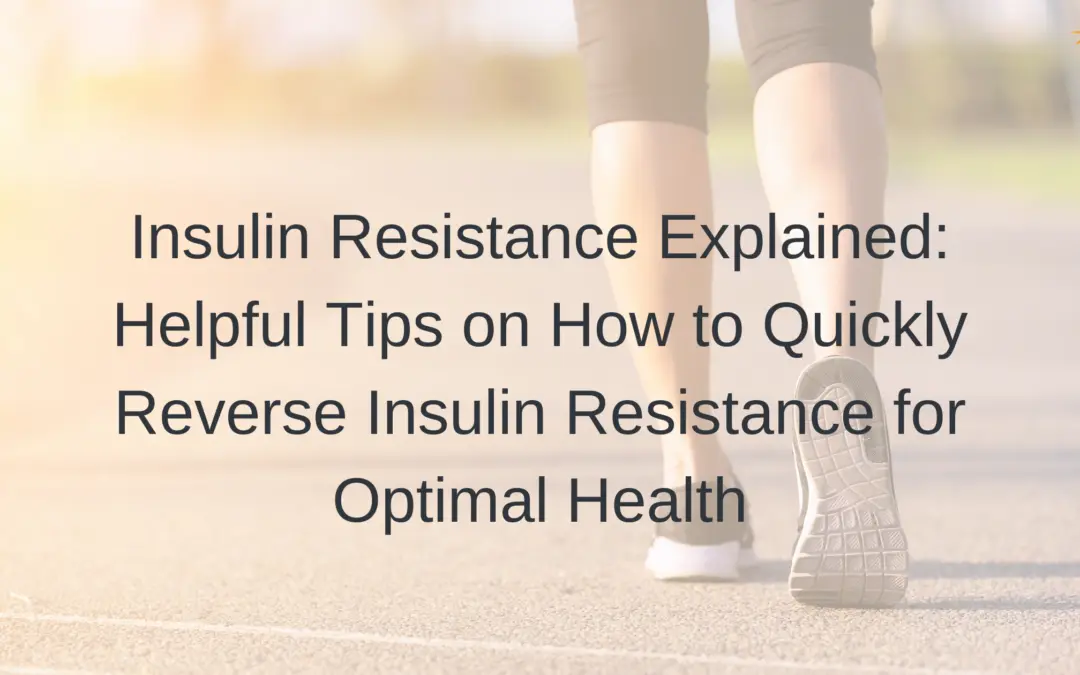Insulin Resistance Explained: Helpful Tips on How to Quickly Reverse Insulin Resistance for Optimal Health
The topic of insulin resistance is pretty prominent in health and wellness today. And for good reason. Insulin resistance and metabolic syndrome can lead to many health conditions, including type 2 diabetes. With obesity and type 2 diabetes on the rise, more and more people are looking for help with their health.
In this article, we’ll discover more about insulin resistance, what it is, and how we can reduce insulin resistance in a safe and natural way.
What is Insulin Resistance?
Insulin resistance occurs when your cells don’t respond well to insulin. What does this mean?
When you eat, your pancreas releases insulin to take the glucose from your food to your cells. Your cells use glucose for energy. Each cell has a little receptor that has to be “unlocked”. And insulin has the key.
Insulin brings glucose to the “door” of your muscle, liver, and fat cells and tries to unlock it. But the cell resists. Insulin’s key is not working.
This creates a problem because now insulin can’t do its job. Your body recognizes that your blood glucose level is still high, so it tells the pancreas to release even more insulin to help. Your cells continue to resist, and over time, your blood sugar levels creep up.
What are the Symptoms of Insulin Resistance?
Normally, when we are sick, we experience symptoms. We might have a cough or runny nose if we have a cold. But there aren’t any symptoms like that with insulin resistance. Insulin resistance quietly and slowly builds up in your body over time.
While there aren’t any symptoms of insulin resistance, there are some signs that you may be resistant to insulin. Some of these signs are:
- Waist measurement over 35 inches for women
- High triglycerides
- HDL cholesterol (the “good” cholesterol) under 50 mg/dl for women
- A fasting glucose level over 100 mg/dl
- High blood pressure readings
If you suspect that you may be insulin resistant, you can get a blood test that measures your blood sugar levels.
Metabolic Syndrome
Metabolic syndrome is a health condition that may affect as many as one in six Americans. It’s not a disease in and of itself. It is a group of risk factors. These risk factors include the signs of insulin resistance listed above. Even having only one of these signs or risk factors isn’t good. But when you have two or more of them, your risk for heart disease and diabetes increases. If you have at least three of these risk factors, you have metabolic syndrome.
What is the Main Cause of Insulin Resistance?
If you have one or more of the signs of insulin resistance listed above, you may wonder how you developed them. Many factors can make you more likely to have this condition. They include things like:
- Obesity, especially extra belly fat
- Smoking
- Age – 45 or older
- Sedentary lifestyle
- Diet high in simple carbohydrates and sugar
- Gestational diabetes
- Fatty liver disease
- PCOS (polycystic ovary syndrome)
- Poor sleep habits and sleep problems
- Medications such as steroids and antipsychotics
- Hormonal disorders
That’s quite a long list! Some of these we can’t help, like your ethnicity or age. But others are completely within your control.

Can I Reverse Insulin Resistance?
You may wonder how you can reverse insulin resistance. Take a look at the list above of insulin resistance causes. How many apply to you?
The good news is you can take the necessary steps to reverse it. It will take consistent effort over time, but you can start today to implement a few simple changes to your lifestyle.
How do you Treat Insulin Resistance?
The first step to treating insulin resistance is to go to your health care provider and get a physical check. Ask for the recommended tests to determine your insulin and blood glucose levels. You’ll want to get a thorough picture of your current state of health. You’ll use this as a benchmark as you work towards better health.
I recommend to get both Fasted Glucose and Fasted Insulin blood work. It will permit you to calculate your HOMA-IR stands for Homeostatic Model Assessment of Insulin Resistance. Your HOMA-IR will give you a better perspective of your health.
Exercise
Getting regular exercise is one of the best ways to help reduce insulin resistance. When you exercise, you need energy. You have stored energy in your cells. By using this stored energy, you can start to reduce insulin resistance.
Work towards getting at least 30 minutes of moderate exercise for at least five days per week. If you’re not active right now, start with ten minutes and work up to thirty. Some great options include going for a brisk walk, attending a yoga class, or riding a bike. Physical activity is absolutely crucial.
Healthy Weight
Insulin resistance and weight loss go hand in hand. Over 42% of American adults are considered obese. That is a staggering number with many health implications. But how do you know what a healthy weight is for you?
One tool often used is the Body Mass Index or BMI. Your height and weight are used to calculate your BMI. To find your BMI quickly, you can use a BMI Calculator.
- If your BMI is less than 18.5, you fall within the underweight range.
- If your BMI is 18.5 to 24.9, you are in the normal and healthy weight range.
- If your BMI is 25 to 29.9, you are in the overweight range.
- If your BMI is 30 or higher, you are in the obese range.
Healthy Diet
Eating a healthy diet is one way to help reduce insulin resistance. You don’t need to do anything crazy or eat special foods. You can start by reducing sugar and processed foods, and reduce saturated fat intake. Start drinking less sugary sodas, juices, artificial sweeteners and drink more water.
Next, you can add in things like green leafy and cruciferous vegetables, berries, nuts, fish, and lean protein. An insulin resistance diet is best when followed for the long term. When you change your approach to food and stop crash dieting, you slowly build new and lasting health habits.
Insulin Resistance and Intermittent Fasting
Remember when we talked about how the cell resists the insulin? Insulin has the key to open the cell’s receptor, but the key isn’t working. Well, it’s not that the key is bad, the issue is that the cell is full. The cell would like to let insulin unlock the receptor and receive the glucose, but the cell is already full and can’t take in any more glucose.
Have you ever tried to squeeze into an elevator that’s already full? Everyone can shuffle around and make a little room, but at some point, the elevator reaches its capacity and no one else can get in.
The only way to make more room is if someone gets off the elevator. It’s the same with our cells. The energy already stored in the cell has to be used. The cell has to be emptied before it can accept any more glucose.
So how can we empty those cells and get rid of insulin resistance?
One way is through exercise as mentioned above. When you exercise, you use the energy stored in the cell.
Another way to reduce insulin resistance is through intermittent fasting. Intermittent fasting is the practice of fasting for a period of time, then eating for a period of time. There are different methods of intermittent fasting. You can fast for a certain number of hours per day or alternate fasting days with feasting days.
When you fast, you use the glucose already stored in your cells for energy. Since there is no more food energy coming in, your blood glucose levels and insulin levels both drop. Studies on intermittent fasting show that fasting blood glucose is reduced by 3-6% and fasting insulin levels are reduced by 20-31%.
Intermittent fasting helps reduce insulin resistance by allowing the cells to use their stored glucose for energy. Once the cell is empty, insulin can now access the cell to drop in more glucose from your bloodstream.
Final Thoughts on Insulin Resistance
Insulin resistance is a serious issue. But as we’ve discovered, we can reverse it healthily and naturally. By implementing a few lifestyle changes, you can greatly improve your health while reducing insulin resistance.
I’ve given you several pointers, but it’s not always easy to make these types of health changes on your own. You may still have many questions about what you should eat, when you should eat, and how much exercise you should get.
I’ve worked with many women just like you who want a little extra help. My job as an intermittent fasting coach is to help you navigate your health journey through customized, one-on-one support.
I know from experience that having a support system increases your rate of success. I’ve created a process that works for you, and for the many women before you.
I want to get to know you and learn about your struggles. I’m ready to build your personalized program tailored to your specific goals. I’ll be your personal guide through your intermittent fasting program. Along the way, I’ll send you tons of free resources.
Click the button below to schedule your first free consultation with me.




